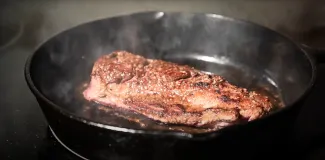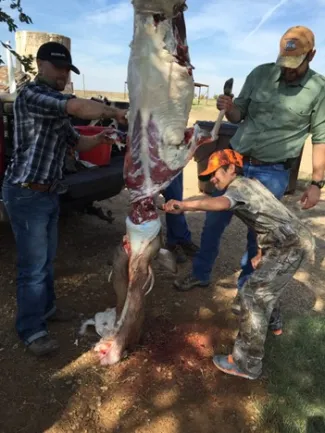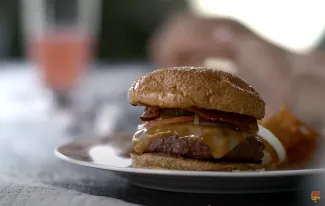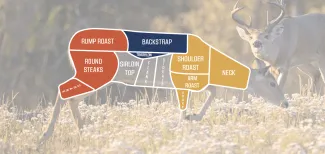There are numerous reasons to go deer hunting: the adventure, the tradition, the opportunity to connect with nature, and the nutritious meat it provides. With grocery prices on the rise, I'm especially eager to fill my freezer with deer meat this year. As a family of four, having nutritious, self-harvested meat gives me peace of mind knowing we're eating healthy and saving money. This led me to explore the health benefits of deer meat. Below is what I discovered. I hope it encourages you to enjoy the outdoors, harvest venison, and prepare it this season:

Nutrition Benefits
Venison, a red meat that's low in calories and high in protein, is a nutritional powerhouse. The nutrients in venison supports muscle growth, repair, and energy levels, which is very beneficial for active lifestyles. Venison contains L glutamine, an amino acid that helps build muscles, removes excess ammonia (waste) from the body, and boosts metabolism. In addition, venison is packed with B vitamins, zinc, iron, and essential fatty acids, which are crucial for immune function, cardiovascular health, and cell repair.
Feeding farm raised animals corn and grain increases both their total fat and omega-6 fatty acid levels. According to the Linus Pauling Institute, omega-6 fatty acids elevate inflammation markers in the body.
Unlike many farm raised animals, wild venison doesn't contain added hormones, resulting in a more natural nutrient profile. Animals that graze freely on a natural diet tend to have higher omega-3 fatty acids and conjugated linoleic acid (CLA), both of which are linked to anti-inflammatory benefits and help fortify the immune system. Venison also provides a higher nutrient density, supporting a healthy diet.
For those who embrace outdoor living and sustainable practices, venison is a nutritious, eco-conscious choice to support an active lifestyle.
Resources: Overview of Inflammation Inflammation | Linus Pauling Institute | Oregon State University, extension.psu.edu/venison-is-it-for-you

Processing Your Own Deer:
Processing your own deer might seem daunting at first, but don't let that stop you from giving it a try. There are plenty of benefits! Not only will you save money over time, but you will also know exactly where your meat comes from and ensure that no part of the deer goes to waste. Plus, learning this new skill can be very rewarding, and it's a great opportunity to get the family involved. Kids love to help, and it's an excellent way to teach them about deer anatomy. The Wildlife Department's website has a lot of great resources to get you started:

Time to Cook!
Venison is an incredibly versatile meat, perfect for everything from steaks and sausages to meatballs, stews, casseroles, and more. You can use venison in any recipe that calls for beef or other red meat. You can even save the bones to make a nutrient-rich bone broth. Venison is known for its rich, distinct flavor and lean texture. Venison is also good when it is cooked low and slow to really bring out its full-flavored taste. You can mix bacon, beef or pork fat into your ground venison so that burgers and other meals will stay juicy and flavorful. There are countless venison recipes available online, and YouTube is full of helpful cooking tutorials. No matter how you prepare it, you'll enjoy the pride that comes from knowing the journey behind your meal - from field to table.

Simplified Licensing Requirements
It is easier than ever to determine the appropriate licenses for deer hunting. New this year, resident and nonresident adult hunters need only an annual hunting license and a single deer license for the season they plan to hunt. Youth under 18 years old need only a youth annual super hunting license. Learn more about this here:
Bag Limits and Regulations
Find your legal bag limits and regulations here:
Hunters Against Hunter
Hunters who legally harvest a deer during any of this year’s deer seasons can donate the meat to feed hungry Oklahomans. Simply deliver the deer to the nearest participating meat processor (listed below) after you check in the deer. To help with processing charges, each donor is asked to contribute a tax-deductible $10 to assist with the program. That fulfills your obligation unless you wish to pay the entire processing fee, which is a tax-deductible donation as well. The ground venison will then be distributed to the needy through a network of qualified, charitable organizations.
Oklahoma Deer Share
Hunters play a vital role in helping maintain a healthy deer population. A key goal for a healthy herd is an even buck-to-doe ratio, making antlerless harvest critical. In order to help supplement hunters who want to help harvest more does and share that harvest with others, we have set up a Deer Share page to help coordinate hunters transferring their harvest to someone interested in obtaining fresh deer meat.
We recommend those planning to harvest a deer post their information on this page before their hunt so someone interested can hopefully reach out to them before the hunt and make a commitment to accepting the harvest. This way, upon a successful hunt they can quickly transfer the fresh harvest to the interested party who can then quickly process the deer themselves or deliver it to a local processor.
Back Straps and Inner Tenderloins
These two are grouped together because they are typically cooked the same way.
- Remove the silver skin from the backstraps.
- Cook backstraps like steak, but avoid cooking them beyond medium since they have little fat.
- Marinate half a backstrap in your favorite marinade for two days.
- Grill to an internal temperature of 135°F, let rest, and slice ¼-inch thick across the grain.
- Sprinkle slices with coarse-ground steak seasoning.
- Sauté the inner tenderloins with garlic, butter, and seasonings.
- Slice backstraps thinly and tenderize as you would for beef.
Hind Quarters
Hind quarters are larger than front quarters, with bigger muscle groups that allow for more versatility.
- Remove the hind quarters at the hip's ball-and-socket joint and separate the leg into individual muscle groups.
- Wrap each muscle separately for future use.
- Remove the silver skin before cooking.
- Slice ½-inch thick, tenderize, and fry for chicken-fried steaks.
- Slice thinly to make jerky.
- Cook whole as a roast.
- Cube for stew meat.
- Cut ¾-inch thick across the grain and grill to 135°F.
- Slice into strips for fajitas.
- Thinly slice for Asian dishes like Mongolian beef.
Front Shoulders
These cuts often have connective tissue and may show damage or hemorrhaging from bullets or broadheads.
- Trim away all damaged meat.
- Separate the shank at the elbow and slow-cook it whole with the bone in, like a roast.
- Cut boned-out meat into chunks for stew.
- Remove the meat from the bone and use it for grinding.
Trimmings
Use leftover trimmings that aren’t suitable for steaks or roasts for grinding.
- Ground venison works well as a substitute for ground beef.
- Purchase an affordable grinder online or have a local processor grind and package it for you.
- Grind venison coarsely and very lean for chili.
